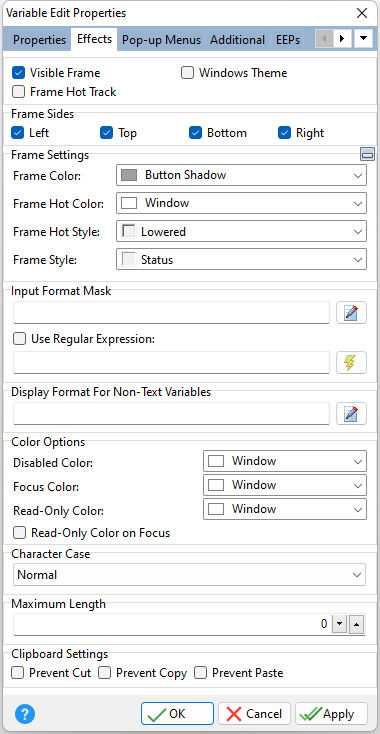ð Visible Frame Displays object frame when checked
ð Frame Hot Track Enables the frame to glow when the mouse enters the control
ð Windows Theme Applies the current Windows theme to the control
ð Frame Sides Specifies which sides of the border are visible
ð Frame Settings Frame Color Specifies the color of the frame Frame Hot Color Specifies the glow color of the frame when "Hot Track" is enabled Frame Hot Style Specifies the hot style of the frame when "Hot Track" is enabled Frame Style Specifies the style of the frame
ð Input Format Mask Specifies keystroke restrictions and formatting for data entry actions. Refer to chart below. Use the provided button, or press [F6] for example formats.
ð Use Regular Expression Specifies a regular expression characters string to define a search pattern, which can be used to validate user input. A button is available to validate the regular expression.
ð Display Format for Non-Text Variables Specifies the display format for integer, date, time, etc. values. Use the provided button, or press [F6] for example formats.
ð Color Options Disabled Color Specifies the background color of the control when disabled Focus Color Specifies the background color of the control when focused Read-Only Color Specifies the background color of the control when set to "read only" Read-Only Color on Focus Enables the "Read-Only" Color if the cursor focus is on the control
ð Character Case Specifies a case of the entered characters, which are converted as the user types. Changing the Character Case property changes the actual contents of the text, not just the appearance. Any case information is lost and can't be recaptured by changing Character Case to Normal. Supported Options: Normal, Upper Case, Lower Case, Word Case, Sentence Case, Title Case
The Title Case option does not capitalize the second value in a hyphenated string. An application PROPERTY was implemented to alter the behavior of Title casing, where the first letter in the second value of a hyphenated string is made upper case. The default value is OFF.
PROPERTY APPLICATION HYPHEN_AS_WORD_SEPARATOR ON
ð Maximum Length Limits the number of characters for user input. Default = 0 (maximum = 4092 characters)
ð Clipboard Settings Prevent Cut Specifies whether text can be cut from the field Prevent Copy Specifies whether text can be copied from the field Prevent Paste Specifies whether text can be pasted into the field |
|
Character |
Meaning in Format Mask |
! |
If a ! character appears in the mask, optional characters are represented in the returned string as leading blanks. If a ! character is not present, optional characters are represented in the returned string as trailing blanks. |
> |
If a > character appears in the mask, all characters that follow are in uppercase until the end of the mask or until a < character is encountered. |
< |
If a < character appears in the mask, all characters that follow are in lowercase until the end of the mask or until a > character is encountered. |
<> |
If these two characters appear together in a mask, no case checking is done and the data is formatted with the case present in the Value parameter. |
\ |
The character that follows a \ character is a literal character. Use this character to use any of the mask special characters as a literal. |
L |
The L character requires an alphabetic character only in this position. For the US, this is A-Z, a-z. |
| |
The l character permits only an alphabetic character in this position, but doesn't require it. |
A |
The A character requires an alphanumeric character only in this position. For the US, this is A-Z, a-z, 0-9. |
a |
The a character permits an alphanumeric character in this position, but doesn't require it. |
C |
The C character requires an arbitrary character in this position. |
c |
The c character permits an arbitrary character in this position, but doesn't require it. |
0 |
The 0 character requires a numeric character only in this position. |
9 |
The 9 character permits a numeric character in this position, but doesn't require it. |
# |
The # character permits a numeric character or a plus or minus sign in this position, but doesn't require it. |
: |
The : character is used to separate hours, minutes, and seconds in times. If the character that separates hours, minutes, and seconds is different in the regional settings of the Control Panel, that character is substituted in the returned string. |
/ |
The / character is used to separate months, days, and years in dates. If the character that separates months, days, and years is different in the regional settings of the Control Panel, that character is substituted in the returned string. |
; |
The ; character is used to separate the three fields of the mask. |
_ |
The _ character automatically inserts spaces into the returned string. |
Any character that does not appear in the preceding table can appear in the first part of the mask as a literal character. Literal characters are inserted automatically if the second field of the mask is 0, or matched to characters in the Value parameter if the second field is any other value. The special mask characters can also appear as literal characters if preceded by a backslash character (\).
For more information, see Using Format Masks in Forms.
